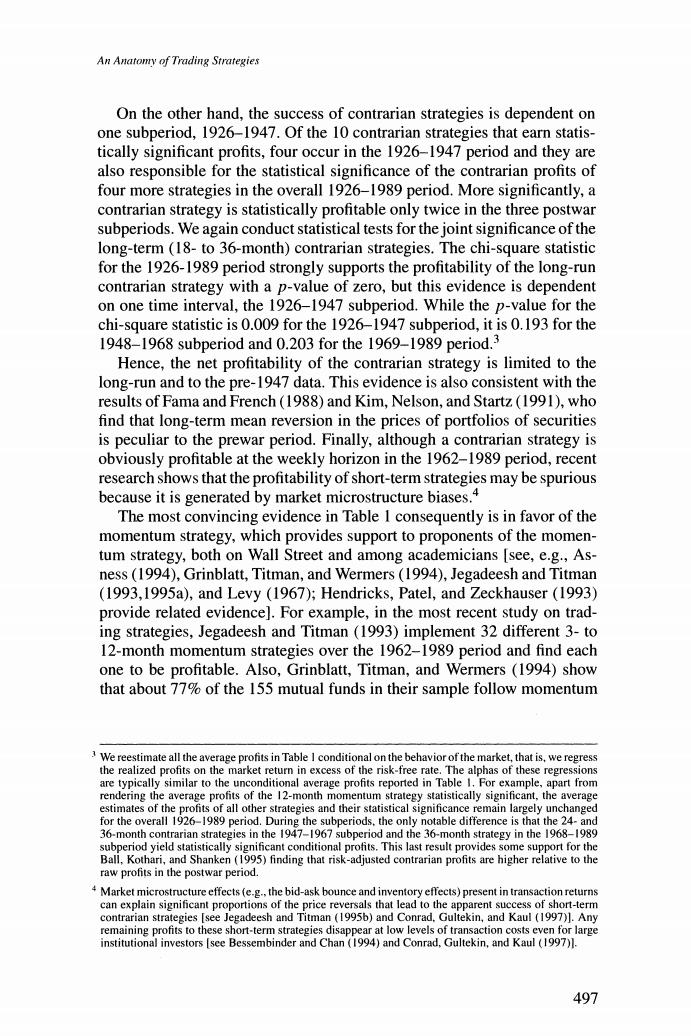正在加载图片...

An Anatomy of Trading Strategies On the other hand,the success of contrarian strategies is dependent on one subperiod,1926-1947.Of the 10 contrarian strategies that earn statis- tically significant profits,four occur in the 1926-1947 period and they are also responsible for the statistical significance of the contrarian profits of four more strategies in the overall 1926-1989 period.More significantly,a contrarian strategy is statistically profitable only twice in the three postwar subperiods.We again conduct statistical tests for the joint significance of the long-term (18-to 36-month)contrarian strategies.The chi-square statistic for the 1926-1989 period strongly supports the profitability of the long-run contrarian strategy with a p-value of zero,but this evidence is dependent on one time interval,the 1926-1947 subperiod.While the p-value for the chi-square statistic is 0.009 for the 1926-1947 subperiod,it is 0.193 for the 1948-1968 subperiod and 0.203 for the 1969-1989 period.3 Hence,the net profitability of the contrarian strategy is limited to the long-run and to the pre-1947 data.This evidence is also consistent with the results of Fama and French(1988)and Kim,Nelson,and Startz(1991),who find that long-term mean reversion in the prices of portfolios of securities is peculiar to the prewar period.Finally,although a contrarian strategy is obviously profitable at the weekly horizon in the 1962-1989 period,recent research shows that the profitability of short-term strategies may be spurious because it is generated by market microstructure biases.4 The most convincing evidence in Table I consequently is in favor of the momentum strategy,which provides support to proponents of the momen- tum strategy,both on Wall Street and among academicians [see,e.g.,As- ness (1994),Grinblatt,Titman,and Wermers (1994),Jegadeesh and Titman (1993,1995a),and Levy (1967);Hendricks,Patel,and Zeckhauser (1993) provide related evidence].For example,in the most recent study on trad- ing strategies,Jegadeesh and Titman(1993)implement 32 different 3-to 12-month momentum strategies over the 1962-1989 period and find each one to be profitable.Also,Grinblatt,Titman,and Wermers (1994)show that about 77%of the 155 mutual funds in their sample follow momentum We reestimate all the average profits in Table I conditional on the behavior of the market,that is,we regress the realized profits on the market return in excess of the risk-free rate.The alphas of these regressions are typically similar to the unconditional average profits reported in Table 1.For example,apart from rendering the average profits of the 12-month momentum strategy statistically significant,the average estimates of the profits of all other strategies and their statistical significance remain largely unchanged for the overall 1926-1989 period.During the subperiods.the only notable difference is that the 24-and 36-month contrarian strategies in the 1947-1967 subperiod and the 36-month strategy in the 1968-1989 subperiod yield statistically significant conditional profits.This last result provides some support for the Ball,Kothari,and Shanken (1995)finding that risk-adjusted contrarian profits are higher relative to the raw profits in the postwar period. 4Market microstructure effects (e.g.,the bid-ask bounce and inventory effects)present in transaction returns can explain significant proportions of the price reversals that lead to the apparent success of short-term contrarian strategies [see Jegadeesh and Titman(1995b)and Conrad.Gultekin,and Kaul (1997)].Any remaining profits to these short-term strategies disappear at low levels of transaction costs even for large institutional investors [see Bessembinder and Chan (1994)and Conrad,Gultekin,and Kaul (1997)1. 497